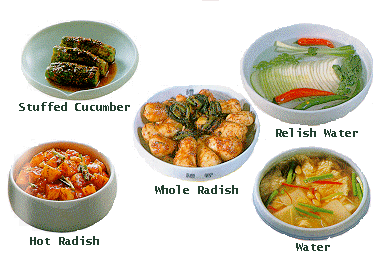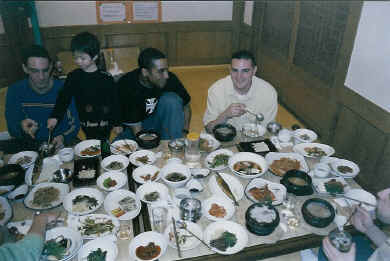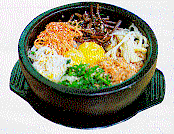KOREAN FOOD
![]()
Home
Korean Food
Fun
Facts
Little Things
Homesick
Travels
Blog
Email Me
Generally speaking, Korean food is very spicy and contains a lot of garlic. I like most Korean dishes, but tend to go more toward the milder options. Luckily, several dishes are served with red pepper paste on the side so you can control the spice level. When it comes to breakfast, however, I'm totally American. Koreans don't have western style breakfast foods. I found this out several years ago when visiting my brother & sister-in-law in Seoul. We were having breakfast at a mountain resort. Mike and I ordered pancakes. Jung Soo got the bone marrow soup. Here's a brief sample of Korean foods.
| RICE Don't be fooled, not all rice is created equal. I tried very hard to create the same rice I'd experienced in restaurants. It was not until I purchased a rice cooker that I achieved success. It's the greatest appliance my kitchen has ever housed. Throw in a little rice, add some water, close the lid and boom 20 minutes later perfect sticky rice. It's a beautiful thing. |
|
|
KIMCHI I've heard there are over 200 varieties of Kimchi. In the most basic of definitions, its fermented cabbage. Yeah that's right, fermented cabbage. Preparations for kimchi include washing and salting the cabbage and covering it with red pepper and garlic. After pickling (not sure how that happens) the mixture is put into a large earthenware pot and buried. These pots keep kimchi fresh while it ferments through the winter months. The final result is a super hot and apparently healthy side dish that accompanies every meal. Now before you go anti-kimchi let me offer you some other options. Kimchi is, without question, an acquired taste. I recommend taking baby steps. The cucumber or radish kimchis are excellent introductions. Both contain the same spices as the above variety, but are much milder and haven't gone through the fermentation process. The style I've come to enjoy is what I refer to as "fresh" kimchi. This is made with cabbage, but like the cucmber and radish, skips fermentation. It can still be quite hot, but is a bit less pungent than the traditional style. |

|
| BULGOGI / KALBI HOUSE Bulgogi is considered Korean BBQ. The marinated meat is often grilled with onions and served with rice. The best way to have it, however is at a Kalbi house. There, you grill the meat at your table. A variety of large lettuce leaves are used much like a burrito's tortilla. Slices of beef are rolled into the lettuce leaf along with rice, spicy bean paste, and garlic cloves. Several side dishes are included in the meal. It resembles family style dining except you don't have an individual plate. You do, however, get your own bowl of rice. All side dishes are cut into bite sized pieces that can be picked up with chopsticks. |

Example of side dishes served with bulgogi. |
|
BIBIMBAP |
 Bibimbap
bowl Bibimbap
bowl |
Cynthia Woertz, 2005